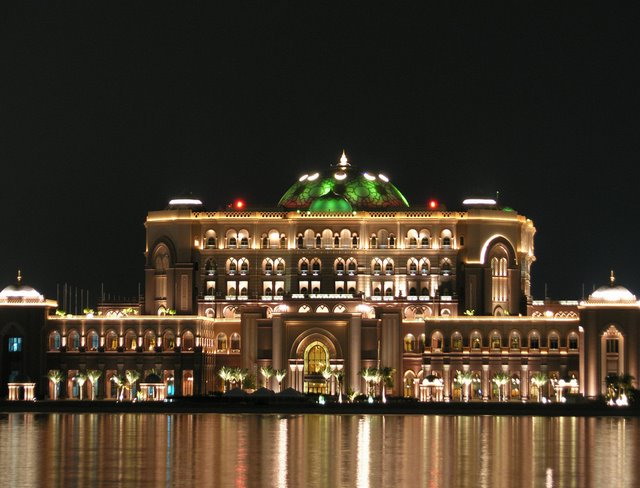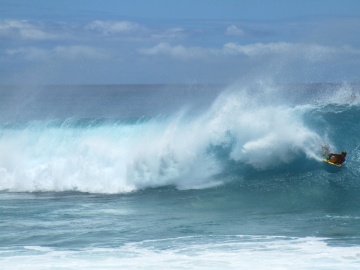Costa Rica is home to some of the best waves on the planet, crashing along beaches that are clean and blissfully empty.
The Caribbean
For those surfing on the Caribbean coast, keep in mind that the surfing season doesn't last long, and most of the waves are produced by tropical storms off the Mexican coast. However, these storms produce some of the biggest waves in the country and should only be attempted by veteran riders.
Puerto Viejo also known as Salsa Brava, is home to some of Costa Rica's biggest waves. A coral reef off the coast produces Hawaiian-style breaks that often carry over 20 surfers at a time. Located in the Limon province, Puerto Viejo is a vibrant seaside town with gorgeous waters and waves that tempt surfing pros.
Westfalia extends south from Limon to Cahuita, offering breaks from the left and right. The best part of Westfalia is its reliability -- it offers consistently good surf, but be forewarned of the riptides and jellyfish.
Portete beach is located very close to Limon, so you'll have easy access to the small bay. It's also a great spot for swimming and snorkeling if you're the only surfer in the family. Portete is also close to Playa Bonita, where you can test out some bigger waves.
North Pacific Coast
The North Pacific Coast is encompassed by the Guanacaste Province and is the country's most visited region. However, this area, home to some of the best and most easily accessible diving and surfing spots, is also one of Costa Rica's least populated regions.
Playa Naranjo, more commonly known as Witch's Rock, is one of the best breaks in the country, with some very strong offshore winds between December and March. There aren't any resorts or hotels located here, but nearby Witch's Rock Surf Camp is the perfect place to stay and learn. Instructors will teach you the basics and shuttle you and other newbies to the famous swells of Playa Naranjo. You can also camp out, but 4-wheel drive is a must and don't forget a mosquito net.
Playa Grande provides consistent swells and breaks, making it one of the best overall surf spots in the country. It also offers a quieter spot than beaches like Playa Tamarindo and the beach's north side is a great location for swimming, safe from the dozens of surfers tearing through the Costa Rican waters.
Playa Negra is a right-handed point break that the locals describe as epic. The waves are as powerful as they are reliable. For experienced surfers, the ride is best when the waves are breaking overhead, so head to Playa Negra on days when storms are kicking up some aggressive surf.
Central Pacific Coast
This region is the most easily accessible, just a short distance from San Jose. The resort towns offer a bit more nightlife than the other coasts, and the surf here is fantastic, making Central Pacific the place for a more lively vacation.
A beach that offers one of Costa Rica's longest rides, Boca Barranca is a left break in front of a river mouth. You can ride these waves over half a mile when the conditions are right, so if you longboard, this is the beach for you. There's great access to this beach, so it's best to arrive early to avoid crowds.
Playa Escondida is an excellent point break for rights and lefts. For members of the beach club, the surf is accessible by land. If you're just visiting, rent a boat from Playa Jaco or Playa Herradura. These waves are best surfed at high tide, so check tide times before hitting the surf.
Hermosa beach juts out into the Pacific Ocean, giving the waters there constant swell. The beach stretches for several miles, so you should be able to stake out your own territory. Some of the best breaks occur off a sandbar located in front of a large tree known as the Almendro. Ask a local to point out this primo spot.
South Pacific Coast
Unlike the Central Pacific Coast, the South Pacific is home to some of the largest last remaining stretches of Pacific Coastal rainforests. This is the coast surf if you're only packing a wetsuit, a board and a sleeping bag -- you're surfing with Madre Nature.
Playa Dominical offers beautiful lush landscapes and waves for all skill levels. On the north end of the beach in front of the Baru River mouth, the surf is a little bigger and provides a challenge for skilled surfers.
Pavones is a left point that offers one of the longest rides in the world. This beach is located 8 hours from San Jose by car, but you're welcome to pack your camping gear and stay a few nights. Rides here can last over three-quarters of a mile, considered one of the longest in the world. The surf here can be fickle, with the best surf occurring between April and November.
Cabo Matapalo is located directly across the bay from Pavones and catches the same ocean swells. Matapalo is much less surfed than Pavones, so if you're looking to avoid crowds or just learning, this is an excellent beach for you. It's drivable from Pavones, so make sure to hit both of these spots on your surfing tour of Costa Rica.
 Travel Attraction In Australia
Travel Attraction In Australia
 Are you aware of US Virgin Islands? Maybe, you don’t even know that such a country exists. If you know it, you probably hear it because of Tim Duncan. But actually, there is a country called so and it has pretty high tourism revenue compared to small area of it.
Are you aware of US Virgin Islands? Maybe, you don’t even know that such a country exists. If you know it, you probably hear it because of Tim Duncan. But actually, there is a country called so and it has pretty high tourism revenue compared to small area of it. Even though, the set of islands are quite isolated, one can arrive in the country by plane since there are two airports belonging Saint Croix and Saint Thomas.
Even though, the set of islands are quite isolated, one can arrive in the country by plane since there are two airports belonging Saint Croix and Saint Thomas.


 The North Pacific Coast is encompassed by the Guanacaste Province and is the country's most visited region. However, this area, home to some of the best and most easily accessible diving and surfing spots, is also one of Costa Rica's least populated regions.
The North Pacific Coast is encompassed by the Guanacaste Province and is the country's most visited region. However, this area, home to some of the best and most easily accessible diving and surfing spots, is also one of Costa Rica's least populated regions. This region is the most easily accessible, just a short distance from San Jose. The resort towns offer a bit more nightlife than the other coasts, and the surf here is fantastic, making Central Pacific the place for a more lively vacation.
This region is the most easily accessible, just a short distance from San Jose. The resort towns offer a bit more nightlife than the other coasts, and the surf here is fantastic, making Central Pacific the place for a more lively vacation. Unlike the Central Pacific Coast, the South Pacific is home to some of the largest last remaining stretches of Pacific Coastal rainforests. This is the coast surf if you're only packing a wetsuit, a board and a sleeping bag -- you're surfing with Madre Nature.
Unlike the Central Pacific Coast, the South Pacific is home to some of the largest last remaining stretches of Pacific Coastal rainforests. This is the coast surf if you're only packing a wetsuit, a board and a sleeping bag -- you're surfing with Madre Nature. Sentosa Island situated in Singapore is known for its peace and harmony. It is an island resort which is visited by millions of people all round the year. Apart from being the holiday spot there are lots of events organized here. The island is a popular tourist spot where you will experience a perfect blend of silence and recreation. The Sentosa Island is a fun filled attraction that caters to the needs of the visitors.
Sentosa Island situated in Singapore is known for its peace and harmony. It is an island resort which is visited by millions of people all round the year. Apart from being the holiday spot there are lots of events organized here. The island is a popular tourist spot where you will experience a perfect blend of silence and recreation. The Sentosa Island is a fun filled attraction that caters to the needs of the visitors. The Sentosa Island is full of amazing tours that also include the wonderful parks. These are Butterfly Park, Underwater World, Insect Kingdom and lots more to explore on this island. You will feel great pleasure here as it is a very quiet place where the kids and family can have fun and spend some time together. A complete entertaining trip can be experienced which is unforgettable.
The Sentosa Island is full of amazing tours that also include the wonderful parks. These are Butterfly Park, Underwater World, Insect Kingdom and lots more to explore on this island. You will feel great pleasure here as it is a very quiet place where the kids and family can have fun and spend some time together. A complete entertaining trip can be experienced which is unforgettable. Another very well known attracting includes the Songs of the Sea. This chain began in the year 2007 which was done as a part of the musical fountain show. It is spectacular show which last for about 25 minutes and takes place twice a day. The visitors are delighted by watching the show but a fee is also charged which can range from $10 to $15. The show is organized in an open air hall that has the capacity of accommodating about 25000 people.
Another very well known attracting includes the Songs of the Sea. This chain began in the year 2007 which was done as a part of the musical fountain show. It is spectacular show which last for about 25 minutes and takes place twice a day. The visitors are delighted by watching the show but a fee is also charged which can range from $10 to $15. The show is organized in an open air hall that has the capacity of accommodating about 25000 people.


 Aurland is an extremely wonderful place that you can visit with your family and friends during the summer or winter vacations. In this article, I would mainly like to provide you some essential information that you need about this mesmerizing destination.
Aurland is an extremely wonderful place that you can visit with your family and friends during the summer or winter vacations. In this article, I would mainly like to provide you some essential information that you need about this mesmerizing destination.

 Visit the fashion world with style. Milan, Italy is one of the most cosmopolitan and hip cities across Europe. It also offers some of the most luxurious accommodations anywhere.
Visit the fashion world with style. Milan, Italy is one of the most cosmopolitan and hip cities across Europe. It also offers some of the most luxurious accommodations anywhere.  If you are a refreshing change from some places of historical and cultural attractions in Venice, you can pause on the Lido of Venice Beach. One of the main attractions is the beautiful beach of Lido is situated in a beautiful natural environment.
If you are a refreshing change from some places of historical and cultural attractions in Venice, you can pause on the Lido of Venice Beach. One of the main attractions is the beautiful beach of Lido is situated in a beautiful natural environment. 



